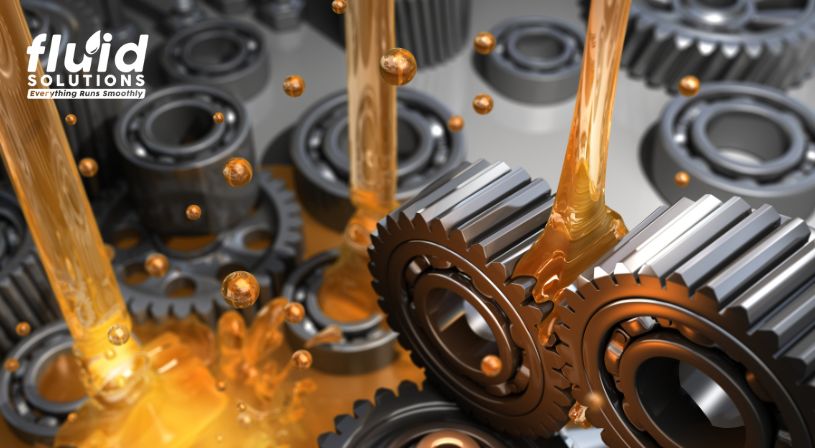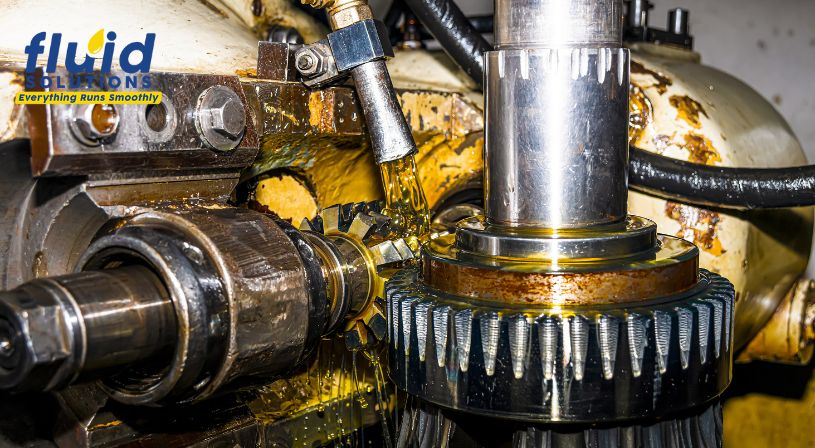
In industrial machinery, the gearbox is a critical component that drives efficiency and ensures smooth operations. However, this hardworking mechanism is only as reliable as the oil that keeps it running. Therefore, regular gear oil testing is recommended, as it provides information on the health of your gearbox and the conditions it endures.
Oil condition tests do more than monitor lubricant condition—that acts as an early warning system for wear debris, contaminants such as water, particle count, and oil degradation. These factors, if left unchecked, can lead to costly equipment failures and downtime. Integrating oil analysis into your maintenance routine can uncover hidden issues, extend equipment lifespan, and optimize performance, keeping your operations running like a well-oiled machine.
This blog discusses the essential oil tests you need to know and how to interpret their results effectively. Whether you’re a maintenance manager or an industrial technician, these insights will help you harness the full potential of gearbox oil analysis for maximum performance.
Key Oil Tests for Gearboxes
Effective gearbox maintenance begins with understanding the health of the oil that lubricates and protects its components. Conducting regular oil tests provides valuable insights into potential issues, allowing you to take corrective action before serious damage occurs. Here are the key tests every gearbox oil analysis should include:
1. Viscosity Test
Viscosity is the cornerstone of oil performance. This test measures whether the oil retains its proper flow characteristics under operating conditions. Too high viscosity can increase internal friction and temperature, while too low viscosity can compromise lubrication, leading to the premature wear of machine components. Maintaining the right viscosity ensures smooth gear operation and optimal performance.
2. Water Contamination Test
Water can wreak havoc on a gearbox, leading to corrosion, pitting, and reducing oil efficiency. This test identifies harmful water levels, helping you address leaks or condensation issues before they damage internal components.
3. Particle Count Analysis
This test examines the presence of contaminants such as dirt, metal shavings, and other particles that can enter the gearbox. High particle counts can indicate wear or contamination, potentially pointing to compromised seals or inadequate filtration.
4. Oxidation Stability Test
Over time, exposure to heat, air, and contaminants can degrade oil, reducing its effectiveness. The oxidation stability test evaluates the oil’s resistance to breaking down under these stresses, ensuring it continues to protect the gearbox for the recommended service interval.
5. Wear Metals Analysis
This analysis detects minute particles of metal generated by gear wear and tear. Identifying wear metals early helps pinpoint stressed components, allowing for repairs or adjustments before they escalate into significant failures.
By incorporating these tests into your maintenance program, you can keep your gearbox running smoothly, reduce unplanned downtime, and extend the life of your machinery.
How to Interpret Gearbox Oil Test Results
Interpreting the gearbox oil testing results is as important as conducting the tests themselves. Proper analysis of the findings enables you to proactively maintain your equipment’s health. Here’s a breakdown of typical results and actions to take when results fall outside acceptable limits.
Breakdown of Typical Results and What They Indicate
1. Viscosity Test Results
- Normal: The oil retains its specified viscosity grade, such as ISO VG 150, ISO VG 220, ISO VG 320, or ISO VG 460, which aligns with the manufacturer’s recommendations. This ensures proper lubrication, adequate film strength, and efficient heat transfer under normal operating conditions.
- Abnormal: Deviations from the recommended viscosity grade, such as a noticeable thinning or thickening of the oil (e.g., an ISO VG 220 oil behaving like ISO VG 150, or ISO VG 460), may indicate issues like contamination with fuel or water, thermal breakdown due to excessive heat, or the use of an incorrect oil type for the application. Look for signs such as oil that appears unusually thick, sticky, or runny compared to its expected consistency.
2. Water Contamination Test Results
- Normal: Water content remains within acceptable industry limits (typically less than 0.1% for most lubricants), ensuring no significant risk of corrosion, foaming, or degradation of lubricant performance. The oil should appear clear, with no visible emulsification, cloudiness, or separation when inspected visually.
- Abnormal: Elevated water levels, often exceeding 0.1% or as defined by specific equipment tolerances, may manifest as cloudy oil, the presence of free water, or emulsified layers. These results can indicate sources such as leaks in seals, condensation from temperature fluctuations, or exposure to high-humidity environments. Immediate action should be taken to identify and address the source of water ingress.
3. Particle Count Analysis Results
- Normal: Particle counts fall within acceptable cleanliness standards for the specific system, as defined by ISO 4406:1999 cleanliness codes. For example, a code of 16/14/11 indicates that the number of particles per milliliter of fluid is within the following ranges:
- 16: 320 to 640 particles ≥ 4 µm
- 14: 80 to 160 particles ≥ 6 µm
- 11: 10 to 20 particles ≥ 14 µm
This level of cleanliness suggests effective filtration and minimal wear debris, contributing to optimal system performance.
- Abnormal: Elevated particle counts, such as an ISO code of 20/18/15, correspond to the following particle concentrations per milliliter:
- 20: 5,000 to 10,000 particles ≥ 4 µm
- 18: 1,300 to 2,500 particles ≥ 6 µm
- 15: 160 to 320 particles ≥ 14 µm
Such increased levels indicate contamination, component wear, or inadequate filtration. Addressing these issues promptly is essential to prevent equipment damage and ensure reliable operation.
4. Oxidation Stability Test Results
- Normal: The oil demonstrates high oxidation stability, as indicated by standard tests such as the Rotating Pressure Vessel Oxidation Test (RPVOT) or the Turbine Oil Oxidation Stability Test (TOST). For example, in the RPVOT (ASTM D2272), a new turbine oil may exhibit an oxidation induction time of several hundred minutes, reflecting robust resistance to oxidative degradation. Similarly, in the TOST (ASTM D943), the time required for the oil to reach an acid number of 2.0 mg KOH/g can extend to several thousand hours, indicating strong oxidation stability.
- Abnormal: A significant reduction in oxidation stability is observed when test results show a marked decrease from the baseline values of new oil. For instance, if the RPVOT result drops below 25% of the original value, it suggests that the oil’s antioxidants are depleted, and the oil is nearing the end of its useful life. In the TOST, a substantially shorter time to reach the 2.0 mg KOH/g acid number threshold compared to the new oil baseline indicates accelerated oxidation. Such findings necessitate prompt evaluation and possible replacement of the oil to maintain equipment protection and performance.
5. Wear Metals Analysis Results
- Normal: Wear metal concentrations are within acceptable limits, indicating minimal component wear and effective lubrication. For example, in gear oils, typical acceptable values are:
- Iron (Fe): less than 300 ppm
- Lead (Pb): less than 75 ppm
- Copper (Cu): less than 275 ppm
- Chromium (Cr): less than 30 ppm
- Aluminum (Al): less than 40 ppm
- Silver (Ag): less than 30 ppm
These levels suggest that the gears and bearings are operating under normal conditions without significant distress.
- Abnormal: Elevated concentrations of wear metals exceeding the typical acceptable values may indicate early signs of component wear or potential mechanical issues. For instance, iron levels surpassing 300 ppm could suggest excessive gear or bearing wear. Similarly, higher-than-normal levels of lead or copper might point to bearing or bushing degradation. Such findings warrant further investigation to identify the root cause and implement corrective actions to prevent equipment failure.
Actions to Take When Test Results Exceed Limits

- Flushing and Cleaning
If contamination or oxidation is significant, consider flushing the gearbox to remove degraded oil and particulates.
- Replacing Oil
When viscosity, oxidation, or contamination levels surpass acceptable thresholds, a complete oil change may be necessary to restore optimal performance.
- Component Inspection and Repairs
High wear metal levels or particle counts should prompt a closer inspection of gears, seals, and filters to identify and address underlying issues.
- Improving Maintenance Practices
Reviewing oil test data regularly can reveal patterns that inform better lubrication schedules, filtration upgrades, or environmental controls.
Benefits of Regular Oil Testing
Implementing a routine oil testing program is one of the most effective ways to maintain gearbox health and ensure operational efficiency. The benefits extend beyond simple maintenance, offering tangible advantages that impact performance and profitability.
1. Increased Equipment Reliability and Reduced Downtime
Regular oil testing allows for the early detection of issues such as contamination, wear, or oil degradation. Addressing these problems before they escalate ensures your gearbox operates reliably, reducing the risk of unexpected failures. Fewer breakdowns mean less downtime, keeping your operations running smoothly and meeting productivity targets.
2. Cost Savings from Early Detection of Problems
Oil testing is a cost-effective preventive measure that saves money in the long run. By identifying potential problems early, you can avoid expensive repairs, extend the life of components, and minimize the need for emergency replacements. Additionally, optimizing lubrication and maintenance schedules ensures that your gearbox operates at peak efficiency, reducing operational costs.
Regular oil testing is not just a maintenance practice; it’s a strategic investment in the performance, longevity, and reliability of your equipment.
Fluid Solutions: Your Partner in Gearbox Maintenance
Fluid Solutions is a trusted distributor of premium gear oils and lubricants, dedicated to helping businesses optimize their equipment’s performance. With 16 years of experience and a deep commitment to quality, we offer solutions designed to keep your gearboxes running smoothly. Our offerings help businesses:
- Ensure optimal performance with high-quality gear oils and lubricants.
- Extend equipment lifespan by using the right oil for the job.
- Minimize downtime and maintenance costs with reliable lubrication solutions.
By choosing us as your gear oil supplier, you can rest assured that you are using products that enhance your gearbox’s efficiency and longevity. Our expert team is available to guide you in selecting the right products and interpreting oil analysis results, ensuring your equipment runs at peak performance.
Contact our experts today at (02) 8370 5928 / (0917) 894 9156 or via email at inquiry@fluidsolutions.com.ph to learn more about our comprehensive services and how we can help you unlock the full potential of your gearbox.
Social Media Links:
Facebook: https://www.facebook.com/fluidsolutionsinc
LinkedIn: https://www.linkedin.com/company/fluid-solutions-inc


